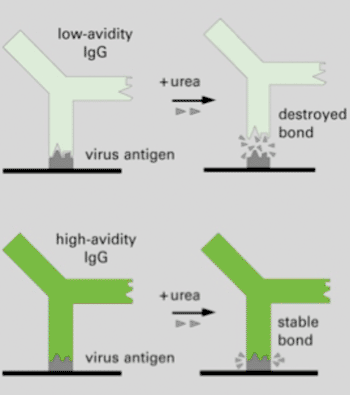Avidity Tests Discriminate Between Acute and Past Infections
By LabMedica International staff writers
Posted on 27 Aug 2012
Avidity assays discriminate between acute and past infections by determining the avidity of specific Immunoglobulin G (IgG) antibodies. This is particularly important in pregnancy diagnostics, where an acute infection may pose a risk to the fetus.Posted on 27 Aug 2012
The Euroimmun AG (Luebeck, Germany) avidity portfolio includes enzyme-linked immunosorbent assays (ELISA) and indirect immunofluorescence tests (IIFT) and comprises infections caused by the following organisms: Toxoplasma gondii, Rubellavirus, Epstein-Barr virus, West Nile virus, Cytomegalovirus, varicella zoster virus, measles virus, and Tick-borneencephalitisvirus (TBE).

Image: Diagram illustrating urea action on high vs. low IgG avidity (Photo courtesy of Euroimmun).
On first contact with an infectious agent, the immune system cannot induce matching antibodies. But over time the B-lymphocytes adapt to the pathogen and the avidity of the specific IgG increases by several powers. Thus, the detection of high-avidity antibodies is a reliable indication that an infection took place some time ago, whereas low-avidity antibodies indicate an acute infection.
All assays incorporate an incubation step with a urea solution, which destroys the weak bonds between low-avidity antibodies and the antigenic target, while leaving the stable bonds formed by high-avidity antibodies intact. Bound antibodies are then detected according to the usual ELISA or IIFT procedure.
The investigation of IgM antibodies is traditionally used to identify acute infections, but it has several limitations: IgM may be only transient or may not be reliably detected in an acute infection, or IgM may persist for months or years after recovery, making interpretation difficult. In these instances, avidity testing can clarify the diagnosis without the need to take a second sample from the patient.
Related Links:
Euroimmun AG














